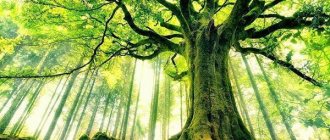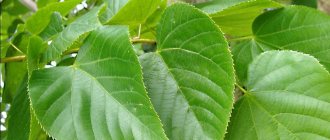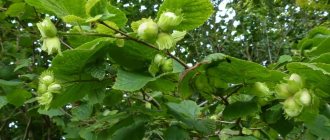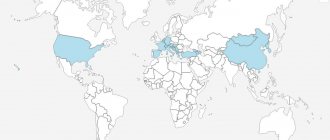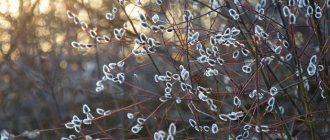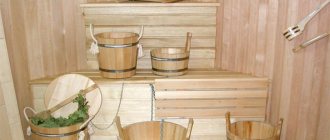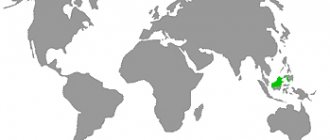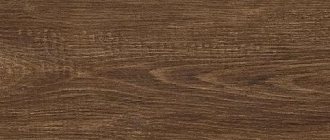Elm tree, description
The leaves are serrated from 2 to 16 cm, depending on the species. They have a characteristic asymmetrical base and taper towards the top. The leaves are arranged alternately on the shoots, forming a thick, dense crown.
Red-violet flowers, collected in inflorescences of several pieces, appear along the shoots in March or early April. After pollination, small winged fruits are formed in place of the flowers, which are carried by the wind.
Elm seeds that fall into the ground germinate literally in a few days, and the tree begins to bear fruit at the age of 6-7 years.
Garden varieties and types of elm with photos
Mountain elm or rough elm variety "Camperdownie" (Ulmus glabra Camperdownii ). It is a picturesque low tree with a characteristic weeping crown in the form of an umbrella of hard shoots.
The height of "Camperdownii" is usually 2 - 2.5 m. After a few years, the width of the crown can reach 6 - 18 m. The leaves are large, hard, and numerous. In autumn they acquire a golden yellow color.
Weeping elm "Pendula" with a compact crown. Another low-growing variety of mountain elm with shoots that form a green tent. Trees prefer sunny places and fertile soils.
The same type of variety from the Dutch (formerly "Monstros"). A rare dwarf elm, one of its smallest forms. Grows as a compact, round bush. At maturity, its size is only 40 cm in height and 40 cm in width.
The leaves are large, about 4 cm, which is special for this small plant. The unique appearance and shape of the variety fits perfectly into compositions of low-growing shrubs, coniferous crops and cereals.
Cork elm or elm (U. Minor) . Synonyms: small, field or hornbeam elm. In nature, it is a powerful, long-lived tree that grows throughout Europe. Three varieties have become widespread in horticulture.
"Argenteovariegata" . The decorative nature of elm lies in its variegated foliage with white and cream spots. It grows slowly. The height of an adult tree reaches 10 meters, and the width of the crown is 5 meters.
Typical requirements for this species are fertile, moderately moist soil, a sunny location, which enhances the brightness of the foliage color.
In the garden, “Argenteovariegata harmonizes well with other variegated plants, although such original varieties are usually planted separately to create a strong accent in the garden design.
"Webbiana" is an ornamental elm with a unique type of foliage. Throughout the season, the leaves of this tree are slightly curled. It seems that the tree is drying out or sick.
Meanwhile, this is a feature of the varietal form. Produces a wide crown of several large, strong branches. The maximum height is about 4-5 meters. It grows well in moist and fertile soil, but due to the structure of the foliage, which reduces water evaporation, the variety is resistant to prolonged drought.
The most popular and incredibly beautiful variety of this species is Jacqueline Hillier . Compact, low and slow growing tree. Its decoration is small, densely spaced, slightly curled, dark green leaves about 2-3 cm long.
Young leaves are pink. The varietal form is grown both on a standard and in the form of a bush. Can grow in any light. The variety is resistant to diseases and low temperatures, and can grow in fertile and poor soils. After 10 years, its height reaches 1.8 m.
White or American elm (Ulmus americana) . This tree is incredibly hardy; unlike many ornamental varieties and hybrids, it can withstand temperatures down to minus 42 °C! Unfortunately, this species is susceptible to Dutch disease.
Variety "Beebes-Weeping"
The tree has a high, slightly lacy crown. An interesting fact is that the American elm is not sensitive to photoperiod length - it will continue to grow throughout the fall, despite the shortening days, until its growth is stopped by frost.
Application of wood
Elm wood is very dense, density indicators are about 600 kg/m3. A beautiful texture is visible on the cut of the trunk, the core is light brown, the underbark is pale yellow in color. Elm wood is resistant to rotting and deformation , is difficult to split or saw, and is highly polished.
Due to its properties, elm wood has long been used for the production of wheel rims, dishes, and rocker arms. The material was also used in the construction of bridges and dams, and in equipping mines and cellars. Currently, elm wood is used in the form of veneer for artistic decoration of premises.
Elm is used to make parquet, wooden furniture parts, frames, and panels. Often the material is combined with lower quality wood species to give a more aesthetic appearance to the products.
General rules for caring for elm
Species belonging to the genus Ulmus tend to be more demanding when it comes to substrate and moisture levels. Their natural habitats are predominantly wet and fertile areas near rivers. However, the soil must be permeable, since elm does not tolerate stagnant water.
Young elm seedlings after planting require regular watering; the soil should not dry out. Mature trees are watered in the absence of rain and after a snowless winter.
Poor soils are enriched with compost or humus. The ground around the plantings is mulched with a thick layer of compost, bark or pebbles, which avoids moisture evaporation.
Elm care includes sanitary pruning, which is carried out in early spring. Since the shoots grow very slowly, severe shortening is not recommended.
Pests and diseases of elm
Elms were once one of the most popular trees in the European landscape. Unfortunately, in the twentieth century, many of them were affected by Dutch elm disease (DED).
The first symptoms of the disease are observed already at the turn of May and June, when at high temperatures the leaves begin to curl, fall off, and the stems dry out. This disease is quite aggressive, therefore preventive or therapeutic (at the onset of the disease) treatment with Topsin M 500 SC is necessary immediately after the temperature rises above 15 °C.
How to get rid of aphids using folk remedies - read here
The treatment is repeated after 10-14 days, trying to spray the preparation on all parts of the tree. The next treatment is repeated in the summer, and the last one is carried out in the fall. The Dutch hybrid is most susceptible to the disease; other ornamental elms are more resistant.
Medicinal properties
The medicinal properties of elm are little known, but people who have tried to be treated with decoctions and infusions from the bark and leaves of the tree always keep prepared dry elm raw materials at home. The chemical composition of elm leaves and bark is varied : it contains ascorbic acid, tannins, steroids, flavonoids, and phenolcarboxylic acids.
Elm infusions and decoctions reduce inflammation, have an antibacterial effect, and accelerate wound healing. Plant extracts are used to treat diseases of the kidneys, skin, musculoskeletal system, heart and blood vessels, and thyroid gland. A decoction of elm bark is used to gargle for sore throats, and tea from the leaves is drunk for constipation. For hemorrhoids and kidney diseases, baths with the addition of bark decoction are useful. The infusion is used as a lotion for skin rashes and difficult-to-heal wounds.
When treating with infusions and decoctions of elm bark and leaves, it must be taken into account that plant materials can cause hypersensitivity reactions, which manifest themselves in the form of allergies. You also need to understand that not all diseases can be cured with traditional methods; if symptoms worsen, you should definitely see a doctor.
Smooth elm, common
Grows in Russia, the Caucasus, Western Siberia, Kazakhstan, Western Europe.
A tree with a wide, beautiful crown and hanging branches. Young shoots are light brown, fluffy, shiny. The bark is brownish brown. The foliage is round or oblong-ovate. The edges are sharp-serrated; dark green above; in autumn they turn brownish-purple. Brownish, small flowers with purple stamens. Flowering lasts about 10 days.
Shade-tolerant, winter-hardy. Growing quickly. It tolerates cutting well and retains its shape. Drought-resistant, grows only in fresh, deep soils. In urban conditions, on poor soils it grows poorly. Looks good in alley and row plantings.
Decorative forms : silver-variegated; golden-variegated; red - with reddish foliage; cut - with dissected foliage and notches between them. Decorative varieties are planted singly or in groups.
Hornbeam elm
The homeland is the European part of Russia, Kazakhstan, the Caucasus, Western Europe, Central Asia, North Africa. Hornbeam elm grows in deciduous forests.
A tree with a dense crown and dark brown shoots. The foliage is dense, dark green, shiny, varied in shape, bare above and hairy below. In autumn it turns yellow. The flowers of the hornbeam elm are small, reddish-red. The elm blooms before the leaves bloom.
Winter-hardy in steppe and forest-steppe zones. Young shoots freeze over. Hornbeam elm is suitable for the southern regions of our country. The tree is undemanding to soil, but grows well only in moist, nutritious soil. It cuts well and holds its shape. Forms dense hedges. Used in parks and gardens, in masses or groups in combination with other breeds.
Where does it grow and when does it bloom?
Elm trees grow well in fertile soils and, with proper care, reach large sizes. However, in natural conditions they can easily tolerate drought and floods, and easily tolerate severe frosts. Most often, elms grow in the following areas:
- Western Siberia;
- Kazakhstan;
- Southern Urals;
- Caucasus;
- Volga region;
- European countries;
- Scandinavia.
The powerful crown of these trees traps dust well. It often serves as a protective fence as a living plant. A large crown with dense foliage can often be seen in many city parks and gardens. In their natural environment, elms are often found in deciduous forests, along the banks of lakes and rivers. They help create clean plantings.
The flowering period begins very early, in March - April. Small and inconspicuous flowers, collected in bunches in the leaves, are easily pollinated by the wind. The period of fruit ripening depends on climatic conditions. Most often they ripen in April - June. An adult tree begins to bear fruit at the age of 7-8 years.
Small-leaved or squat elm
It grows in the wild in Transbaikalia, the southern and middle parts of the Far East, Japan and Korea. Small-leaved elm grows in mixed forests, on fertile soils.
Tree 15 m in height, or shrub with a rounded crown and thin branches. The leaves are small elliptical, leathery, unequal, with a short apex and a simply or serrated edge, smooth. In spring, the leaves of small-leaved elm are green. The flowers are collected in bunches. Lionfish are buffy or yellow-brown.
Small-leaved elm is light-loving and undemanding to soil richness. Drought-resistant, tolerates replanting, shaping, and pruning well. In terms of growth speed, the squat elm is not inferior to the ash-leaved maple and white acacia, it is more frost-resistant, and tolerates pruning and replanting well. This type of elm has no root shoots, and this is highly valued in park construction. Small-leaved elm has a weeping shape.
Brief information
Elm is a genus of trees in the Elm family. It also has other names: elm, birch bark, ilmovik or elm. There are more than 40 species of elms, most of them are found in the subzone of deciduous forests; closer to the south they can grow in spruce and coniferous forests.
They rarely grow alone; they prefer the vicinity of other trees; elm forests are also rare. On average they live 80-120 years, occasionally living up to 300-400 years. In the first few years they actively grow and develop; after 40-60 years, growth slows down and comes to naught.
Elms can reach 40 meters in height and 2 meters in diameter, and some species can grow as a bush.
The root system does not have a central root: some roots penetrate deep into the soil, the rest are located closer to the surface. On podzolic soils, the roots are close to the surface.
It is important to know:
Many species of elm are on the verge of extinction due to diseases and attacks by pests: leaf beetles, springtails, and fungi.
The leaves are 20 cm in size, have sharp, jagged edges, and are symmetrical. All leaves differ in shape and size, even if they originate from the same shoot - this is easy to see in photos or pictures.
Together they form a very dense crown through which the sun does not pass. Leaf growth begins only after fruit formation, and in the fall the elm is one of the first to lose its leaves.
The flowers are quite small and inconspicuous, growing and developing before the leaves appear. Occasionally, flowering may begin in the fall. The fruits ripen already in April-June (the further south the region, the faster). They are nuts with wings that are carried by the wind throughout the surrounding area.
When placed in moist soil, they begin to grow within a few days. Southern species bear fruit from 5-10 years, northern ones - after 20 years. In addition to seeds, they can reproduce by roots and shoots that appear on stumps.
The economic importance of the plant is quite high:
- The wood of the tree is extremely durable, resistant to dampness and does not splinter easily, but at the same time easily tolerates processing and has high aesthetic qualities. It is often used in furniture making, and was previously used to build ships, weapons and dishes.
- Young shoots and seeds are used to feed livestock.
- Paints are obtained from the bark.
- In medicine, elm is used to combat diseases of the genitourinary system and digestion, and the bark is used for skin diseases.
- Elm is an excellent honey plant loved by bees.
- Elm is often used for urban landscaping, since the crown does not require trimming and does an excellent job of purifying the air.
The plant easily tolerates many unfavorable conditions (drought, rain, severe frost), which makes it an extremely popular and sought-after tree in difficult urban environments. In the wild it chooses deciduous and coniferous forests, and is artificially grown within the city.
Rough elm
It grows under natural conditions in Russia, Central Europe, Scandinavia, and Asia Minor. There are many nature reserves in Russia, the Caucasus, Crimea, and the Baltic states. Rough elm grows in coniferous-deciduous forests, sometimes on calcareous soils.
A tree with a rounded, wide crown, reaching 35 m in height under optimal conditions. The bark on the trunk is brown, the branches are dark brown. The foliage of the slippery elm is large, sharp-toothed along the edges, rough above and coarsely hairy below, on short, pubescent petioles; yellowing in autumn. The flowers are collected in bunches. Flowering lasts 5-7 days. Quite large, green lionfish with a notch at the top, also in dense bunches.
Rough elm grows quickly. Frost-resistant. Tolerates urban conditions well. Drought resistant. Tolerates crown pruning well. Gas resistant. Rough elm propagates by seeds, and decorative forms of elm by grafting. A large tree suitable for single plantings in combination with maple and oak.
Use in landscape design
The elm looks like a mighty, strong tree with a dome-shaped crown. It is the dense foliage that allows it to be used as a barrier against dust, gases, and dirty air for residential areas. Moreover, in addition to such an important practical function, elm forms a beautiful, green landscape.
The crown of elms is often used to create shapes in landscape designs. The density of the branches allows you to cut a wide variety of shapes. Powerful, strong roots of the tree can strengthen the banks of lakes, rivers, and the slopes of ravines. Thus, planting elm, in addition to its decorative function, will fulfill an important, practical role.
Elm is an excellent solution for a personal garden. In addition to the obvious landscaping, it will strengthen the soil. Thanks to this, fertile soils will not slide and will be preserved from weathering and erosion.
When deciding to plant elms, it is important to take into account their subspecies and dimensions. Since the diversity of elm is great, there are both miniature and huge specimens.
So, a tall, spreading tree is not suitable for a small area. And over a large area there will not be enough bushes.
